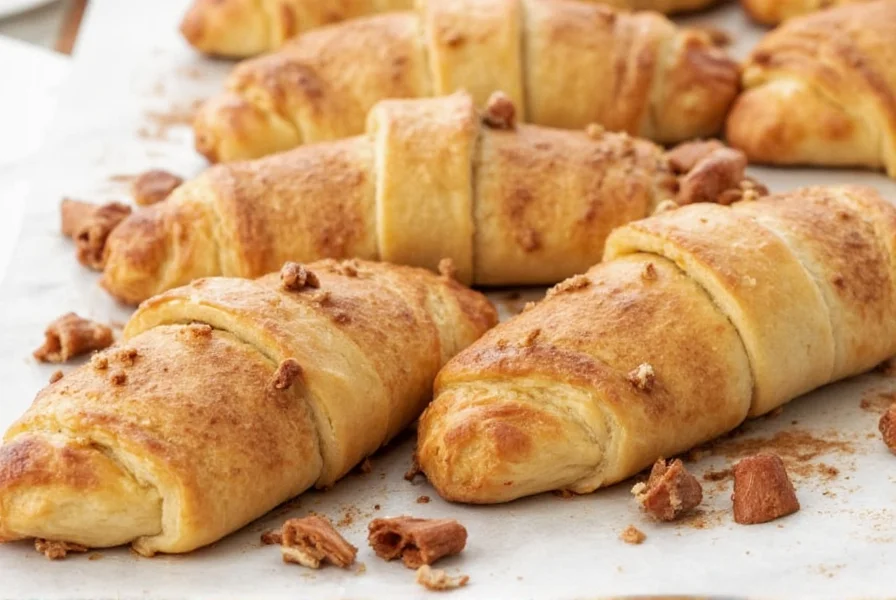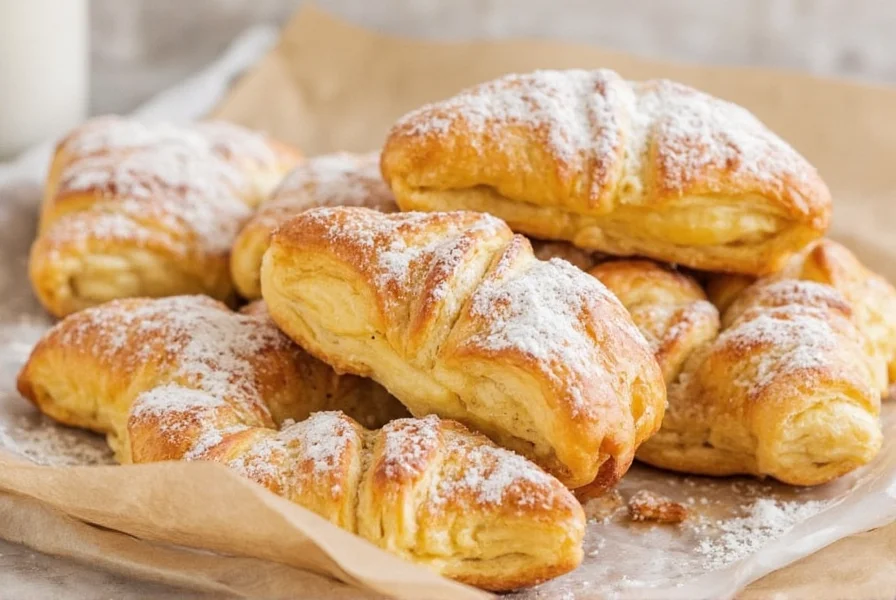Cinnamon toaster strudel has become a staple in American breakfast culture since its introduction by Pillsbury in the 1980s. This convenient pastry offers the comforting flavors of traditional European strudel with the speed modern lifestyles demand. Understanding how to properly prepare and enjoy this product can transform your morning routine from rushed to delightful.
The Evolution from Traditional to Toaster Strudel
Traditional strudel, originating in Austria and popular throughout Central Europe, is a delicate pastry made with paper-thin dough layered with fillings like apples, nuts, or poppy seeds. The transformation to toaster strudel began when food manufacturers recognized the need for convenient breakfast options. Pillsbury's innovation in the early 1980s created a version with specially formulated puff pastry that could withstand freezing and toasting while maintaining its flaky texture—a significant departure from traditional methods that required careful hand-stretching of dough.
Unlike authentic strudel that requires baking in an oven, cinnamon toaster strudel uses a modified dough composition with precise moisture content that allows it to crisp perfectly when exposed to the direct radiant heat of a toaster. This engineering breakthrough made European-inspired pastries accessible to busy households without requiring oven preheating or baking expertise.
Perfect Preparation Techniques
While the package instructions provide basic guidance, achieving restaurant-quality results with cinnamon toaster strudel requires attention to detail. The optimal preparation method varies slightly depending on your appliance:
| Appliance Type | Recommended Setting | Time/Cycles | Special Tips |
|---|---|---|---|
| Standard Toaster | 3-4 | 1 full cycle | Flip halfway through for even browning |
| Toaster Oven | 350°F (175°C) | 8-10 minutes | Place on middle rack; check at 7 minutes |
| Microwave | Medium (50%) | 20-30 seconds | Only for softening; won't achieve crispness |
| Air Fryer | 320°F (160°C) | 3-4 minutes | Best method for extra-crispy results |
For the best texture when using a standard toaster, many pastry chefs recommend the "double-toast" method: run the strudel through on a lower setting first to thaw and warm the filling, then immediately run through again on medium setting to achieve optimal crispness without burning. This technique prevents the common problem of a cold center with an over-browned exterior.

Creative Serving Variations
Beyond the basic preparation, cinnamon toaster strudel offers surprising versatility. Food enthusiasts have developed numerous ways to elevate this convenience food into something special:
- The gourmet breakfast sandwich: Split the warm strudel horizontally and fill with cream cheese and fresh berries
- À la mode version: Serve with vanilla ice cream and a drizzle of caramel for an indulgent dessert
- Breakfast parfait: Crumble cooled strudel and layer with Greek yogurt and fruit
- Stuffed French toast: Use the unfilled pastry sheets (available in some stores) to create homemade stuffed French toast
For those wondering how to make cinnamon toaster strudel crispy without burning, the secret lies in proper toaster calibration. Most modern toasters have inconsistent heating elements, so rotating the strudel 180 degrees halfway through toasting ensures even browning. If your appliance lacks this feature, consider using a toaster oven with a turntable for more consistent results.
Nutritional Considerations
Understanding the nutritional profile helps incorporate cinnamon toaster strudel into a balanced diet. A standard serving (one pastry with icing) typically contains:
- Approximately 190-220 calories
- 6-8g of fat (mostly from the puff pastry)
- 28-32g of carbohydrates
- 14-18g of sugar (including the icing)
- 2-3g of protein
When evaluating cinnamon toaster strudel nutritional information, consider that the primary nutritional drawback is the refined carbohydrates and added sugars. To make a healthier version, try adding a protein source like Greek yogurt on the side, or reduce the icing amount by half. Some health-conscious consumers also experiment with homemade cinnamon toaster strudel recipe variations using whole wheat pastry flour and reduced sugar fillings.
Store-Bought vs. Homemade Options
While commercial cinnamon toaster strudel offers unmatched convenience, understanding the differences between store-bought and homemade versions helps you make informed choices. The main distinctions involve:
- Dough texture: Commercial versions use specially formulated dough that toasts perfectly, while homemade requires precise moisture control
- Fillings: Store-bought uses stabilized cinnamon-sugar mixtures that won't leak during toasting
- Shelf life: Commercial products are designed for freezer storage, while homemade is best consumed immediately
- Customization: Homemade allows for ingredient adjustments and creative fillings
For those interested in the cinnamon toaster strudel vs regular strudel comparison, the key difference lies in preparation method and intended consumption. Traditional strudel is a labor-intensive baked dessert meant to be served warm from the oven, while toaster strudel is engineered specifically for quick appliance-based preparation with consistent results.
Pro Tips from Pastry Professionals
Professional bakers share these insider techniques for maximizing your cinnamon toaster strudel experience:
- Always let the pastry sit at room temperature for 5-7 minutes before toasting for more even heating
- For the best way to heat cinnamon toaster strudel, use the "defrost" setting if your toaster has one
- Warm the icing packet in warm water for 30 seconds before applying for smoother drizzling
- Experiment with toaster oven settings for cinnamon strudel—many find 325°F for 6-7 minutes yields perfect results
- Try unconventional cinnamon toaster strudel serving suggestions like crumbling over oatmeal or using as a pie crust alternative
When troubleshooting common issues, remember that a soggy bottom usually indicates insufficient toasting time, while burnt edges suggest the setting was too high. The ideal result should have golden-brown, crisp pastry with a warm (not hot) cinnamon filling that's fully melted but not leaking excessively.
Conclusion
Cinnamon toaster strudel represents a successful adaptation of traditional European pastry to modern convenience expectations. By understanding its unique preparation requirements and creative potential, you can enjoy this breakfast staple with restaurant-quality results. Whether you're a busy professional needing a quick morning solution or a food enthusiast looking to experiment with convenient ingredients, mastering the art of perfecting cinnamon toaster strudel opens up numerous delicious possibilities. The key lies in proper appliance settings, timing, and embracing both traditional preparation methods and innovative serving ideas that elevate this simple convenience food into something special.
How long should I toast cinnamon strudel for optimal results?
For standard toasters, use setting 3-4 for one complete cycle (approximately 2-3 minutes). The ideal result shows golden-brown pastry with steam rising from the edges. If your toaster has variable darkness settings, aim for medium-brown. Check after the first cycle - if needed, run for an additional 30 seconds on a lower setting.
Can I make cinnamon toaster strudel without the included icing?
Yes, many people enjoy cinnamon toaster strudel without the icing for a less sweet option. The pastry contains cinnamon filling that provides flavor even without the icing. For a healthier alternative, try dusting with powdered sugar, drizzling with honey, or serving with fresh fruit compote instead of the traditional icing.
Why does my cinnamon strudel sometimes become soggy after toasting?
Sogginess typically occurs when the strudel hasn't been toasted long enough to properly evaporate moisture from the filling. Frozen pastries require sufficient time to heat through completely. Try increasing the toasting time by 15-30 seconds or using a slightly higher setting. Allowing the strudel to rest for 1-2 minutes after toasting also helps the pastry crisp up as it cools.
What's the difference between regular and mini cinnamon toaster strudels?
Regular cinnamon toaster strudels (approximately 4x2 inches) contain more filling and require standard toasting times. Mini versions (about 2.5x1.5 inches) toast faster (usually 1-2 minutes) and have a higher pastry-to-filling ratio. Minis work better for children or when serving multiple pastries, while regular sizes provide a more substantial breakfast option with richer cinnamon flavor.
Can I freeze homemade strudel to use like store-bought toaster strudel?
Yes, but with modifications. Standard homemade strudel dough contains more moisture and may become soggy when toasted directly from frozen. For best results, partially bake your homemade strudel first, then freeze. When ready to eat, toast on medium setting for 3-4 minutes. Alternatively, use puff pastry instead of traditional strudel dough for better toaster performance.











 浙公网安备
33010002000092号
浙公网安备
33010002000092号 浙B2-20120091-4
浙B2-20120091-4